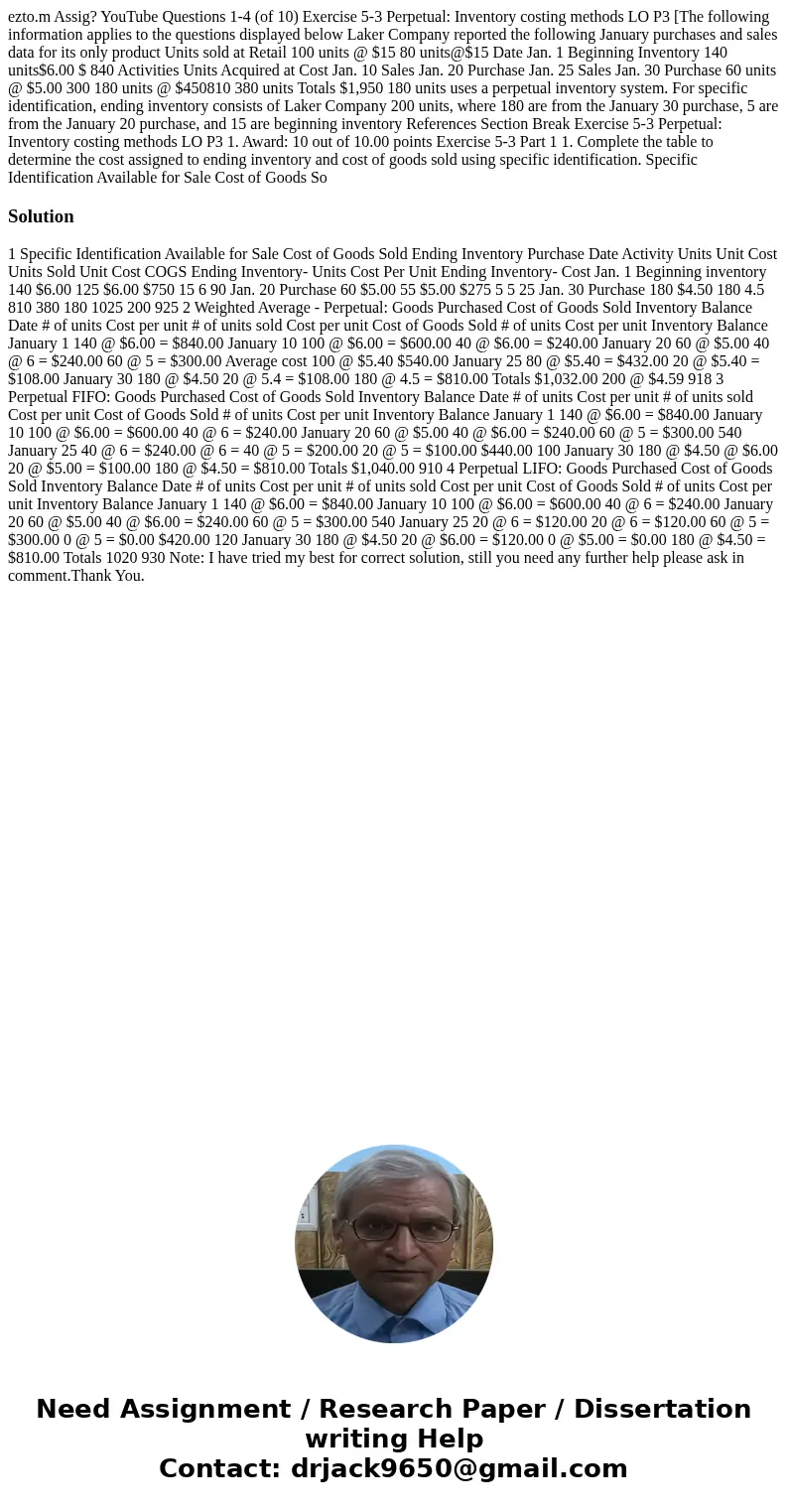eztom Assig YouTube Questions 14 of 10 Exercise 53 Perpetual
ezto.m Assig? YouTube Questions 1-4 (of 10) Exercise 5-3 Perpetual: Inventory costing methods LO P3 [The following information applies to the questions displayed below Laker Company reported the following January purchases and sales data for its only product Units sold at Retail 100 units @ $15 80 units@$15 Date Jan. 1 Beginning Inventory 140 units$6.00 $ 840 Activities Units Acquired at Cost Jan. 10 Sales Jan. 20 Purchase Jan. 25 Sales Jan. 30 Purchase 60 units @ $5.00 300 180 units @ $450810 380 units Totals $1,950 180 units uses a perpetual inventory system. For specific identification, ending inventory consists of Laker Company 200 units, where 180 are from the January 30 purchase, 5 are from the January 20 purchase, and 15 are beginning inventory References Section Break Exercise 5-3 Perpetual: Inventory costing methods LO P3 1. Award: 10 out of 10.00 points Exercise 5-3 Part 1 1. Complete the table to determine the cost assigned to ending inventory and cost of goods sold using specific identification. Specific Identification Available for Sale Cost of Goods So 
Solution
1 Specific Identification Available for Sale Cost of Goods Sold Ending Inventory Purchase Date Activity Units Unit Cost Units Sold Unit Cost COGS Ending Inventory- Units Cost Per Unit Ending Inventory- Cost Jan. 1 Beginning inventory 140 $6.00 125 $6.00 $750 15 6 90 Jan. 20 Purchase 60 $5.00 55 $5.00 $275 5 5 25 Jan. 30 Purchase 180 $4.50 180 4.5 810 380 180 1025 200 925 2 Weighted Average - Perpetual: Goods Purchased Cost of Goods Sold Inventory Balance Date # of units Cost per unit # of units sold Cost per unit Cost of Goods Sold # of units Cost per unit Inventory Balance January 1 140 @ $6.00 = $840.00 January 10 100 @ $6.00 = $600.00 40 @ $6.00 = $240.00 January 20 60 @ $5.00 40 @ 6 = $240.00 60 @ 5 = $300.00 Average cost 100 @ $5.40 $540.00 January 25 80 @ $5.40 = $432.00 20 @ $5.40 = $108.00 January 30 180 @ $4.50 20 @ 5.4 = $108.00 180 @ 4.5 = $810.00 Totals $1,032.00 200 @ $4.59 918 3 Perpetual FIFO: Goods Purchased Cost of Goods Sold Inventory Balance Date # of units Cost per unit # of units sold Cost per unit Cost of Goods Sold # of units Cost per unit Inventory Balance January 1 140 @ $6.00 = $840.00 January 10 100 @ $6.00 = $600.00 40 @ 6 = $240.00 January 20 60 @ $5.00 40 @ $6.00 = $240.00 60 @ 5 = $300.00 540 January 25 40 @ 6 = $240.00 @ 6 = 40 @ 5 = $200.00 20 @ 5 = $100.00 $440.00 100 January 30 180 @ $4.50 @ $6.00 20 @ $5.00 = $100.00 180 @ $4.50 = $810.00 Totals $1,040.00 910 4 Perpetual LIFO: Goods Purchased Cost of Goods Sold Inventory Balance Date # of units Cost per unit # of units sold Cost per unit Cost of Goods Sold # of units Cost per unit Inventory Balance January 1 140 @ $6.00 = $840.00 January 10 100 @ $6.00 = $600.00 40 @ 6 = $240.00 January 20 60 @ $5.00 40 @ $6.00 = $240.00 60 @ 5 = $300.00 540 January 25 20 @ 6 = $120.00 20 @ 6 = $120.00 60 @ 5 = $300.00 0 @ 5 = $0.00 $420.00 120 January 30 180 @ $4.50 20 @ $6.00 = $120.00 0 @ $5.00 = $0.00 180 @ $4.50 = $810.00 Totals 1020 930 Note: I have tried my best for correct solution, still you need any further help please ask in comment.Thank You.
 Homework Sourse
Homework Sourse